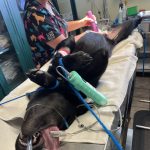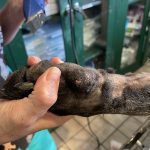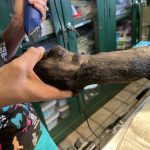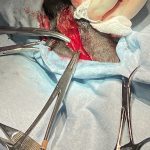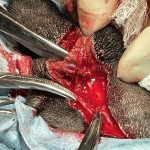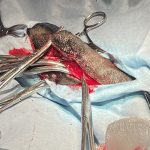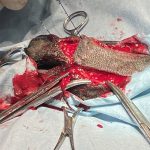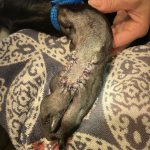This is Apollo. He is a recent rescue. He, like almost all of the rescues we see has a checkered past with more holes than answers. We know what we see in front of us.. male, young, intact and jittery with all of the newness of everything in his life.
He is in foster care as the rescue gets him caught up on vaccines, allows for time to decompress, acclimate and show his true colors. Let his fear assuage to his personality.
This is the story of Apollo’s neuter and mass removal.
I mention both as he was in need of neutering before he found a home of his own, and he had a mass on his wrist that had no accompanying information.
When dealing with a neuter the options are fairly straightforward and simple;
1. neutering is the removal of the testicles from the scrotum. It can be done as an open or closed technique. I decide which based on size of the blood vessels needing ligatures. There shouldn’t be a change in price and the preference is based on the surgeons
2. scrotal ablation with the neuter. For dogs with excessive scrotal tissue (older dogs tend to have larger and more sagging skin). It’s a cosmetic thing in almost all cases. In the trade we call it preventing “the flapjack.”
This is Apollo’s mass. Firm, raised, irregular and without any evidence of what it might be, or, what might have caused it.
As with all masses on pets the only way to identify what it actually is, is to send in a piece of tissue of that mass to a pathologist. There is only guessing outside of tissue. If you are looking for more information on this please read this blog; When a Bump Causes You Concern, Slay It With A Diagnosis.
The next part of a successful surgery is surgical planning. I start every surgery with the plan in my head. The order to which I will execute the surgery, the amount of tissue I want to remove, and the plan for how I will close the area after. You need to know where you are ending before you begin, and then you also need to be prepared for plan B, C, D, etc if the previous doesn’t go as planned/hoped for/expected.
Apollo’s surgery was a challenge because there is not much room on the wrist. I can’t cut too deep, or wide, or have any extra tissue to close after I removed his mass. The mass extended both wide and deep. No room was left over to let me close the sides after I removed the mass.
The goal for every mass removal surgery should be discussed with the pet parents before the anesthesia is turned on.
Ideally every surgical event is what we call a “one and done.” Once surgical expense and event solves the problem. It provides both the diagnosis (meaning we removed a large enough tissue sample that the pathologists feels exceptionally confident in their diagnosis. AND, there are clean margins that prohibit the mass from being able to return.
In all but the most exceptional cases we should never place our patients under repeated anesthetic events, NOR, require additional financial investments from our clients.
Too often I see veterinarians offering surgical services and NOT attempting to remove the mass in its entirety. It is a financial and emotional burden that is placed on patients and clients.
What happens if the mass is malignant? Or, invasive/destructive over time? Do we require clients pay for surgery twice? Put our pets at an anesthetic risk twice, or more? Many clients cannot afford twice? Or, feel the case is not worth the diagnosis the partial mass removal has provided.
Many of the cases that I see have been told the “mass is probably bad” i.e. likely cancerous, or, the pet is too old to put under general anesthesia. People are essentially discouraged from surgical excision of a mass for reasons that too often ;eave them at a place where they are euthanizing their otherwise happy older pet because the mass is now so large it is open, draining, and painful.
I cannot even tell you how many dozens of older pets that we have given extra enjoyed months of time to because we just tried.. we tried, and SUCCEEDED, in the mass removal. See Spencer’s story here.
Apollo’s mass was in a tough spot: the lower leg. It was the size of an acorn on the outside of his wrist.
I had to remove the mass and then make a large flap of skin above where I had removed the mass to close the hole the mass left behind. It is commonplace to close the sides of the site and leave a linear incision, but, the legs don’t leave enough skin to do this.
The fear with an advancement flap is that everything you cut will die. Instead of a quarter sized hole of non healing tissue we have an area three times larger than the mass was.
After Apollo’s surgery I placed a bandage. It serves a few functions;
1. Protects the incision.
2. Allows a few days for the incision to have very little stress on it with movement of the leg.
Apollo one week post op.: The tissue is looking perfect!
Here is the histopath results for Apollo;
Calcinosis circumscripta refers to a non-neoplastic nodular focus of
mineralization and is considered to be a localized subgroup of
calcinosis cutis. The cause of calcinosis circumscripta is currently
unknown, but the majority of cases most likely involve trauma followed
by dystrophic mineralization. In some cases it may be an incidental
finding in young rapidly-growing large breed dogs (especially German
Shepherd dogs). This lesion most commonly occurs at sites of previous
trauma (bite wounds, ear crops), over pressure points (footpad) and
other bony prominences (spine, elbow), and occasionally in the tongue.
There is no evidence of neoplasia, and etiologic infectious agents are
not observed in the examined tissue sections. The lesion appears
narrowly excised.
What makes this case so notable?
1. The rescue made decisions based on what Apollo needed first and foremost. Not cost, but care. His adoptive family knows what his mass was. They don’t have to worry about what it might be. How it will affect his lifespan, and the cost of all of this as a new family member.
2. His mass removal BOTH diagnostic AND curative. Every case in every surgeons hands should start with this as the goal.
3. Apollo has the best chance at success for a future with known information. He’s not a mystery of unknowns. We are filling in answers for him as we discover who he is. He has a solid foundation to succeed!


